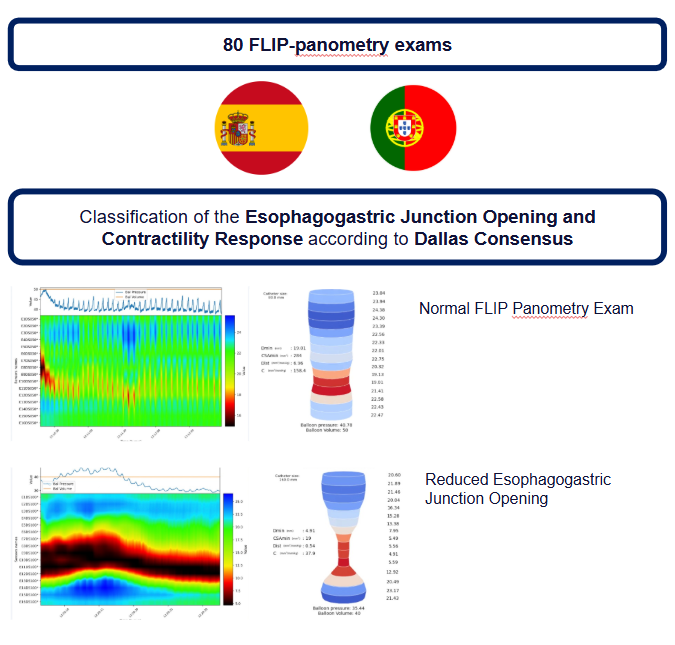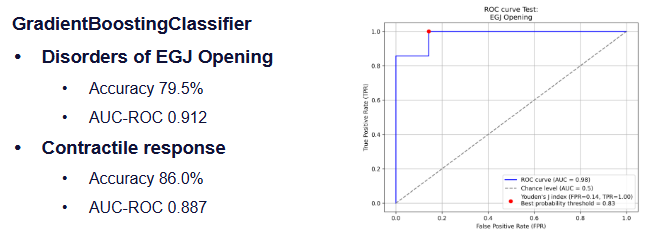Tuesday Poster Session
Category: Esophagus
P4915 - Artificial Intelligence in FLIP Panometry: Multicentric Validation for Esophageal Motility Pattern Recognition
Tuesday, October 28, 2025
10:30 AM - 4:00 PM PDT
Location: Exhibit Hall

Miguel Mascarenhas, MD, PhD
Centro Hospitalar Universitário São João
Porto, Porto, Portugal
Presenting Author(s)
Miguel Mascarenhas Saraiva, MD, PhD1, Francisco Mendes, MD1, Joana Mota, MD1, João Rala Cordeiro, MD2, Miguel Martins, MD1, Maria João Almeida, MD3, Pedro Cardoso, MD1, António Miguel M P D. Martins Pinto da Costa, MD4, Ismael El Hajra Martinez, MD5, Virginia Matallana Royo, MD5, Constanza Ciriza, MD6, João Ferreira, PhD7, Cecilio Santander, MD, PhD8, Guilherme Macedo, MD, PhD1
1Centro Hospitalar Universitário São João, Porto, Porto, Portugal; 2Department of Information Science and Technology, University Institute of Lisbon, Lisbon, Portugal, Porto, Porto, Portugal; 3Centro Hospitalar Universitário de São João, Porto, Porto, Portugal; 4Hospital Universitario Puerta de Hierro-Majadahonda, Madrid, Madrid, Spain; 5Hospital Universitario Puerta de Hierro Majadahonda, Madrid, Madrid, Spain; 6Hospital Clinico San Carlos, Madrid, Spain, Madrid, Madrid, Spain; 7Faculdade de Engenharia da Universidade do Porto, Porto, Porto, Portugal; 8Department of Gastroenterology, Hospital Universitario La Princesa, Madrid, Madrid, Spain
Introduction: Since its development, functional lumen imaging probe (FLIP) panometry has been considered a tool for real time physiological assessment of the esophagogastric junction opening and esophagic body contractile activity during an endoscopic procedure. Despite its promise and the recent development of the Dallas Consensus, real-time determination of the distensibility index and evaluation of the contractile pattern lacks standardization and remains complex. Artificial intelligence models have proven their potential benefit in the analysis of motility patterns in high resolution esophageal manometry, however their role in FLIP panometry lacks has not been explored. This pilot study aims to develop an artificial intelligence model for automatic classification of motility patterns during a FLIP panometry exam.
Methods: This multicenter study included 80 exams from 4 centers from Spain and Portugal. The full dataset included exams performed with both the 8 centimeters and 16 centimeters probe. Several machine learning models were trained and evaluated for detection of FLIP panometry patterns. Each exam was classified according to the recently published Dallas Consensus, based on a consensus reached by two independent experts. The training, validation and testing dataset were divided in a 70%/15%/15% patient split design. Models’ performance was evaluated through their accuracy and area under the receiver-operating characteristic curve (AUC-ROC).
Results: The GradientBoostingClassifer identified disorders of the esophagogastric junction opening with an accuracy of 79.5% and AUC-ROC of 0.912. For classification of the contractile response, The GradientBoostingClassifier model outperformed the remaining machine learning models with an accuracy of 86.0% and an AUC-ROC of 0.887.
Discussion: In this pilot study with integration of exams from different probes and demographic contexts, a machine learning model accurately identified disorders of the esophagogastric junction opening and contractile response during FLIP panometry exams according to Dallas Consensus. Artificial intelligence integration into FLIP panometry studies offers the opportunity to revolutionize the approach to this exam during an endoscopic procedure, by optimizing both exam accuracy, standardization and accessibility, transforming the management of patients with esophageal disorders.

Figure: Study Workflow Diagram and Pannometry Examples

Figure: GradientBoostingClassifier model performance (left) and ROC curve Test for EGJ openning (right)
Disclosures:
Miguel Mascarenhas Saraiva indicated no relevant financial relationships.
Francisco Mendes indicated no relevant financial relationships.
Joana Mota indicated no relevant financial relationships.
João Rala Cordeiro indicated no relevant financial relationships.
Miguel Martins indicated no relevant financial relationships.
Maria João Almeida indicated no relevant financial relationships.
Pedro Cardoso indicated no relevant financial relationships.
António Miguel Martins Pinto da Costa indicated no relevant financial relationships.
Ismael El Hajra Martinez indicated no relevant financial relationships.
Virginia Matallana Royo indicated no relevant financial relationships.
Constanza Ciriza indicated no relevant financial relationships.
João Ferreira indicated no relevant financial relationships.
Cecilio Santander indicated no relevant financial relationships.
Guilherme Macedo indicated no relevant financial relationships.
Miguel Mascarenhas Saraiva, MD, PhD1, Francisco Mendes, MD1, Joana Mota, MD1, João Rala Cordeiro, MD2, Miguel Martins, MD1, Maria João Almeida, MD3, Pedro Cardoso, MD1, António Miguel M P D. Martins Pinto da Costa, MD4, Ismael El Hajra Martinez, MD5, Virginia Matallana Royo, MD5, Constanza Ciriza, MD6, João Ferreira, PhD7, Cecilio Santander, MD, PhD8, Guilherme Macedo, MD, PhD1. P4915 - Artificial Intelligence in FLIP Panometry: Multicentric Validation for Esophageal Motility Pattern Recognition, ACG 2025 Annual Scientific Meeting Abstracts. Phoenix, AZ: American College of Gastroenterology.
1Centro Hospitalar Universitário São João, Porto, Porto, Portugal; 2Department of Information Science and Technology, University Institute of Lisbon, Lisbon, Portugal, Porto, Porto, Portugal; 3Centro Hospitalar Universitário de São João, Porto, Porto, Portugal; 4Hospital Universitario Puerta de Hierro-Majadahonda, Madrid, Madrid, Spain; 5Hospital Universitario Puerta de Hierro Majadahonda, Madrid, Madrid, Spain; 6Hospital Clinico San Carlos, Madrid, Spain, Madrid, Madrid, Spain; 7Faculdade de Engenharia da Universidade do Porto, Porto, Porto, Portugal; 8Department of Gastroenterology, Hospital Universitario La Princesa, Madrid, Madrid, Spain
Introduction: Since its development, functional lumen imaging probe (FLIP) panometry has been considered a tool for real time physiological assessment of the esophagogastric junction opening and esophagic body contractile activity during an endoscopic procedure. Despite its promise and the recent development of the Dallas Consensus, real-time determination of the distensibility index and evaluation of the contractile pattern lacks standardization and remains complex. Artificial intelligence models have proven their potential benefit in the analysis of motility patterns in high resolution esophageal manometry, however their role in FLIP panometry lacks has not been explored. This pilot study aims to develop an artificial intelligence model for automatic classification of motility patterns during a FLIP panometry exam.
Methods: This multicenter study included 80 exams from 4 centers from Spain and Portugal. The full dataset included exams performed with both the 8 centimeters and 16 centimeters probe. Several machine learning models were trained and evaluated for detection of FLIP panometry patterns. Each exam was classified according to the recently published Dallas Consensus, based on a consensus reached by two independent experts. The training, validation and testing dataset were divided in a 70%/15%/15% patient split design. Models’ performance was evaluated through their accuracy and area under the receiver-operating characteristic curve (AUC-ROC).
Results: The GradientBoostingClassifer identified disorders of the esophagogastric junction opening with an accuracy of 79.5% and AUC-ROC of 0.912. For classification of the contractile response, The GradientBoostingClassifier model outperformed the remaining machine learning models with an accuracy of 86.0% and an AUC-ROC of 0.887.
Discussion: In this pilot study with integration of exams from different probes and demographic contexts, a machine learning model accurately identified disorders of the esophagogastric junction opening and contractile response during FLIP panometry exams according to Dallas Consensus. Artificial intelligence integration into FLIP panometry studies offers the opportunity to revolutionize the approach to this exam during an endoscopic procedure, by optimizing both exam accuracy, standardization and accessibility, transforming the management of patients with esophageal disorders.

Figure: Study Workflow Diagram and Pannometry Examples

Figure: GradientBoostingClassifier model performance (left) and ROC curve Test for EGJ openning (right)
Disclosures:
Miguel Mascarenhas Saraiva indicated no relevant financial relationships.
Francisco Mendes indicated no relevant financial relationships.
Joana Mota indicated no relevant financial relationships.
João Rala Cordeiro indicated no relevant financial relationships.
Miguel Martins indicated no relevant financial relationships.
Maria João Almeida indicated no relevant financial relationships.
Pedro Cardoso indicated no relevant financial relationships.
António Miguel Martins Pinto da Costa indicated no relevant financial relationships.
Ismael El Hajra Martinez indicated no relevant financial relationships.
Virginia Matallana Royo indicated no relevant financial relationships.
Constanza Ciriza indicated no relevant financial relationships.
João Ferreira indicated no relevant financial relationships.
Cecilio Santander indicated no relevant financial relationships.
Guilherme Macedo indicated no relevant financial relationships.
Miguel Mascarenhas Saraiva, MD, PhD1, Francisco Mendes, MD1, Joana Mota, MD1, João Rala Cordeiro, MD2, Miguel Martins, MD1, Maria João Almeida, MD3, Pedro Cardoso, MD1, António Miguel M P D. Martins Pinto da Costa, MD4, Ismael El Hajra Martinez, MD5, Virginia Matallana Royo, MD5, Constanza Ciriza, MD6, João Ferreira, PhD7, Cecilio Santander, MD, PhD8, Guilherme Macedo, MD, PhD1. P4915 - Artificial Intelligence in FLIP Panometry: Multicentric Validation for Esophageal Motility Pattern Recognition, ACG 2025 Annual Scientific Meeting Abstracts. Phoenix, AZ: American College of Gastroenterology.
